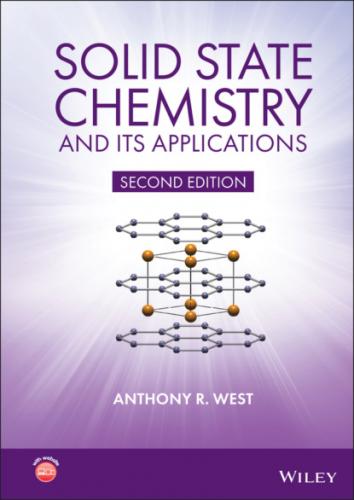8 Chapter 8Figure 8.1 Resistivity of metals, which typically is constant below ~20 K an...Figure 8.2 (a) Polyethylene, (b) polyacetylene, (c) poly‐p‐phenylene and (d)...Figure 8.3 (a) Tetracyanoquinodimethane (TCNQ), (b) chloranil, (c) p‐phenyle...Figure 8.4 Electrical resistance of YBa2Cu3O7 as a function of temperature. ...Figure 8.5 (a) The Meissner effect showing repulsion of a superconductor, S‐...Figure 8.6 Crystal structures of (a) Chevrel phase, (b) ZrCuSiAs and (c) PbF...Figure 8.7 Perovskite‐related cuprate structures showing (a) octahedral, (b)...Figure 8.8 Crystal structure of (a) YBa2Cu3O7 and (b) YBa2Cu3O6. Figure 8.9 (a) Tc versus oxygen contents 7−δ for YBa2Cu3OS showing the impor...Figure 8.10 Conductivity of metals, semiconductors and insulators. Figure 8.11 Relation between electronic properties and magnitude of the band...Figure 8.12 (a) p‐Type semiconductivity in gallium‐doped silicon; (b) n‐type...Figure 8.13 Variation of effective mass, m *, with wave vector, k (d) and it...Figure 8.14 A p‐n junction. (a) Energy levels in p‐type and n‐type semicondu...Figure 8.15 Migration of cation vacancies, i.e. Na + ions, in NaCl. Figure 8.16 Schematic ionic conductivity of doped NaCl crystals. Parallel li...Figure 8.17 (a) Pathway for Na+ migration in NaCl. (b)Triangular interstice ...Figure 8.18 Ionic conductivity of ‘pure’ NaCl as a function of reciprocal te...Figure 8.19 (a) Migration of interstitial Ag+ ions by (1) direct interstitia...Figure 8.20 (a) Effect of Cd2+ on conductivity of AgCl crystals. (b) Effect ...Figure 8.21 Solid electrolytes as intermediate between normal crystalline so...Figure 8.22 Ionic conductivity of some solid electrolytes with concentrated ...Figure 8.23 Oxide layers in β‐alumina showing four‐layer spinel blocks betwe...Figure 8.24 Oxide packing in (a) β″‐ and (b) β‐alumina; structure of the β p...Figure 8.25 Conduction plane in β‐alumina; the base of the hexagonal unit ce...Figure 8.26 Conductivity of some single‐crystal β‐ and β″‐aluminas....Figure 8.27 (a) Crystal structure of NaZr2(PO4)3. (b) Hollandite. Figure 8.28 (a) Crystal structure of α‐Agl showing bcc arrangement of l− ion...Figure 8.29 (a) Conductivity of PbF2 as a function of reciprocal temperature...Figure 8.30 Conductivity data for selected oxygen ion conductors (BICUVOX = ...Figure 8.31 Ionic and electronic conductivity domains as a function of oxyge...Figure 8.32 (a) Conductivity at 100 °C of solid solutions based on Li4SiO4, ...Figure 8.33 Conductivity data for a selection of proton conductors. Figure 8.34 (a) Electrochemical cell containing a solid electrolyte. (b) The...Figure 8.35 (a) Components of a secondary lithium battery; (b) redox potenti...Figure 8.36 A thin‐film electrochromic device based on a tungsten bronze int...Figure 8.37 (a) Oxygen concentration cell with stabilised zirconia solid ele...Figure 8.38 (a) Dielectric material between the plates of a parallel plate c...Figure 8.39 Response of various electroceramic materials to a small applied ...Figure 8.40 (a) The polar water molecule, (b) reorientation of water molecul...Figure 8.41 Dipole orientation (schematic) in (a) a ferroelectric, (b) an an...Figure 8.42 (a) Dielectric constant of barium titanate ceramic. (b) Curie‐We...Figure 8.43 (a) Antiferroelectric‐ferroelectric transition in PbZrO3 as a fu...Figure 8.44 Displacement of phosphorus within a pO2(OH)2 tetrahedron giving ...Figure 8.45 Phase diagram for the PZT system. Figure 8.46 A multilayer ceramic capacitor. Figure 8.47 Positive temperature coefficient resistivity in semiconducting B...
9 Chapter 9Figure 9.1 Schematic magnetic phenomena in a 1D crystal: (a) paramagnetism; ...Figure 9.2 Variation of flux density or number of lines of force in (a) diam...Figure 9.3 Reciprocal of susceptibility versus temperature for substances th...Figure 9.4 Some properties of ferromagnetic materials: (a) saturation magnet...Figure 9.5 Antiferromagnetic coupling of spins of d electrons on Ni2+ ions t...Figure 9.6 Rectangular hysteresis loop showing coercivity, Hc, and remanence...Figure 9.7 Ferromagnetic ordering in bcc α‐Fe, fcc Ni and hcp Co. Figure 9.8 Occupied energy levels (shaded) and density of states N (E) for 3...Figure 9.9 Schematic splitting of 3d band into two sub‐bands: (a) in the abs...Figure 9.10 Magnetic structure of antiferromagnetic and ferrimagnetic spinel...Figure 9.11 Variation of magnetic moment with composition for ferrite solid ...Figure 9.12 Variation of magnetic moment at 0 K of garnets. Curve 1, calcula...Figure 9.13 Spontaneous magnetisation in dysprosium iron garnet. Figure 9.14 Packing arrangement of oxygens and Ba in the magnetoplumbite str...Figure 9.15 Primary and secondary coils wound on a transformer core. Figure 9.16 Read–write magnetic recording head. Figure 9.17 Improvements in magnetic recording densities for floppy disks, r...Figure 9.18 Giant magnetoresistance in FeCr multilayer structures: (a) antif...Figure 9.19 Dramatic decrease in resistivity of Pr0.7Ca0.3MnO3 in response t...
10 Chapter 10Figure 10.1 (a) The electromagnetic spectrum in the region of visible light;...Figure 10.2 (a) Population of energy levels by thermal activation. (b) Energ...Figure 10.3 The interaction of light with a solid. The light can be reflecte...Figure 10.4 Schematic representation of luminescence involving (a) an activa...Figure 10.5 Schematic design of a fluorescent lamp. Figure 10.6 Luminescence spectra of activated ZnS phosphors after UV irradia...Figure 10.7 Ground state potential energy diagram for a luminescent centre i...Figure 10.8 Ground and excited state PE diagrams for a luminescent centre. Figure 10.9 Non‐radiative
